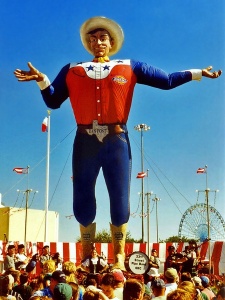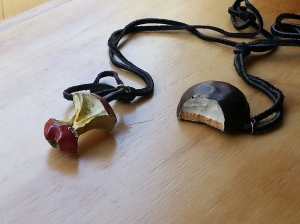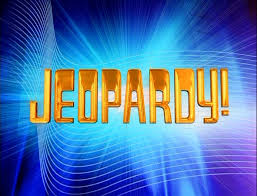I started with the biggest in the nation, the Texas State Fair. 
I’d seen this fair on the silver screen, as it happened, when Ann-Margret starred in the remake of State Fair in 1961. On the last day of school, I took the Rock Island to downtown Chicago, where the star herself was attending the premiere on State Street at one of the Loop’s grand old movie palaces. She was the first movie star I’d ever seen, surprisingly tiny with flaming red hair. I thought the movie was wonderful, and even managed to believe this hot young performer would be smitten with Pat Boone.
When we moved to Dallas in the mid-70s, I was delighted to discover that the Texas State Fair was held right there, in a huge Art Deco park built for the 1936 Texas Centennial, Depression be damned. Here the Fair events were overseen by Big Tex, a man of few words repeated endlessly. From his size 96 boots to his 75 gallon hat, the 52-foot-tall Big Tex was actually kind of creepy, with a hard-chiseled face that made his previous incarnation as a Santa Claus seem almost impossible to believe.
 [Big Tex turned out to be a bad boy of the James Dean/Jett Rink school. He was smoking behind the barn one night in 2012 and burned himself up, sixty years after he first arrived at the fair. His inevitable replacement, Big Tex 2.0, is even larger: three feet taller, twenty gallons more to the hat, etc. etc.]
[Big Tex turned out to be a bad boy of the James Dean/Jett Rink school. He was smoking behind the barn one night in 2012 and burned himself up, sixty years after he first arrived at the fair. His inevitable replacement, Big Tex 2.0, is even larger: three feet taller, twenty gallons more to the hat, etc. etc.]
When I first visited the Texas State Fair, I was fascinated by the exhibits. No product was too minor or obscure not to merit its own state-sponsored booth. Beef, pork, and pecans, of course. But Mohair goats? Who knew? I’d made half a dozen mohair sweaters by then, without ever giving a moment’s thought to where that filmy yarn came from.
And then there were the FFA (Future Farmers of America) and 4H (Head, Heart, Hands, Health) entrants in the livestock competitions.
Livestock is a major matter in Texas, and these kids were damned serious about their animals. I watched in fascination as they teased and hair-sprayed cattle tails into puffy concoctions that looked a lot like the hairdos on their mothers. Their sheep, meanwhile, wore snug-fitting coveralls and terrorist masks to avoid getting dirty before judging, sheep having a tendency to roll in anything that might be on the ground in their pens.
Other competitions came to symbolize fair culture for me, particularly the pride of craftsmanship in culinary and needlework projects. (In the State Fair movie, success seemed dependent on adding vast quantities of hooch to the mincemeat.) I was pretty sure I could compete in some of those events, though the mechanics of entering were always a little fuzzy.
I was hooked on Going to the Fair. How had I come so far in life without having ever attended one? Pretty easily, actually. I grew up in Chicago. I defy anybody to say “Cook County Fair” without at least a snicker.
The next year I went out to Fair Park a couple days before the Fair opened, thinking I’d sell an article about this wacky event to some New York magazine, even though New York magazines were seriously disinterested in my work.
I met a kid named Joey as I walked around, and he offered me a job.
Joey was a carny, with a two-booth operation selling carnival jewelry. I decided on the spot that there was no reason not to do this, which would provide all sorts of interesting material and pay me a little at the same time.
Very little, actually. I talked myself up to $2 an hour, an executive wage in the carnival business back then. I also insisted on being paid daily, which they were reluctant to do because unless you owe your underpaid help money, they have a tendency not to show up.
Perhaps my lowest moment in the hiring process came when Joey’s coworker, who would be my boss on the Midway, asked if I could make change.
“I have a master’s degree,” I told her, a trifle insulted.
“Yes,” she said, “but can you make change?”
The booth where I worked was at the heart of the Midway, between Big Bertha the Fat Lady and the Freak Show, a collection of ten physical anomalies. Loudspeakers touting both ran constantly, though I mostly remember hearing about the Human Blockhead, who drove nails into his head. After about the six hundredth time I heard that recording, I wanted to do the same.
The specialty of our operation was metal pendants and bracelets with your name engraved for free. I am here to tell you that you get what you pay for, though I was never entrusted with that task, being busy making change. It was hard work, this carny business, and I went home exhausted every night.
My favorite of our wares was the Half-Eaten Food Collection, from which I purchased two items: a marshmallow cookie with a bite out of it and a heavy metal apple core, very realistically painted. That apple core, which came on a lengthy leather thong, would make a very effective lethal weapon.
I still have both pieces of jewelry. You just never know.
When we moved to Los Angeles, I figured my fair days were over, but we discovered that there was in fact an LA County Fair in the eastern part of the county. There was no icon comparable to Big Tex, no Big Marilyn or Big Sinatra. You probably wouldn’t have been able to see their heads through the smog anyway. The thick September air not only obscured the nearby mountains, but seemed to hang in palpable chunks on the fairgrounds.
There were plenty of Home Arts exhibits and competitions, which I always thought I should enter and never did. Radio host Dr. Laura Schlesinger won a lot of ribbons for sweaters with complicated patterns and designs. This conflicted me a bit, since she made these on knitting machines, which somehow felt like cheating.
Still, most of the people at the LA County Fair—particularly in the home and livestock events—were very different from those in the beach towns and celebrity enclaves of the western part of the county. Here jeans were clothing, not a fashion statement, and nobody had to lie down and writhe in order to get them on. Kids had a wholesome look, and they too were spraying and ratting the hair on their heifers’ tails, just like their cousins fifteen hundred miles east in Texas.
I never much took to the LA County fair, which among other problems required hours of unpleasant travel across the entire width of the county, right through downtown LA. After a couple of years, we stopped going.
But then we got lucky, and found the Ventura County Fair. On the coast northwest of LA, this fair was probably no closer to our place in Venice, but there was much less traffic and the scenery didn’t involve backed-up underpasses or eighteen-wheelers.
Compared to Texas and LA, this was a tiny little fair, but by then we had a small child and the reduced size was perfect, helping to provide a far more charming experience. My two-year-old daughter ran gleefully around the barns in a pink romper and we discovered the Swifty Swine piglet races, for which I still retain a soft spot. Once again I felt a yearning to compete in Home Arts, though here I had the excuse of nonresidency to cover my failure to enter.
I don’t go to the Fair every year any more. Some years it just doesn’t fit the rest of my life, and my local fair seems huge because it is, seventh largest in the nation. (Texas remains #1 and Los Angeles is a surprising #6.)
The San Diego County Fair renamed itself from Del Mar Fair a few years ago for reasons that were never clear. “Del Mar Fair” sounds more sophisticated, even mildly exotic—but perhaps that’s the problem. Sophistication isn’t really on the agenda at the Fair, which this year featured $20 barbecued turkey legs, each swaddled in a full pound of bacon.
The San Diego County Fair sponsored a lot of the same kind of Home Arts competitions I’d seen elsewhere, and I still kept telling myself I should be entering. I still never did, though the urge grew stronger when I discovered the Collections competitions.
Many were straightforward collections of similar items: tickets to musicals, Pez dispensers, shot glasses, Barbie dolls, coins and stamps, doilies, bakelite purses, Wheaties boxes with famous people on them. Others were more whimsical: a year’s worth of junk mail or dryer lint. The ones from kids were always fun: My Little Ponys, Happy Meal toys, dump trucks, Big Bird in every incarnation, trolls, things found on walks.
I began to notice certain entrants whose names were all over the competitions and collections, including a home-schooled family from a neighboring town entered in multiple categories. They were forever trimming Christmas trees, setting special occasion tables, making jams and cookies, decorating cakes, and collecting, collecting, collecting. I confess I found this overachieving household a bit annoying, though I later got to know the entire family and liked them very much.
After Texas, I never went back to a Midway. I don’t like thrill rides and had met enough carnies to be a little uneasy about maintenance anyway. Nor do I eat much Fair food, particularly of the deep-fried-Snickers variety. But there’s plenty else to see.
I like to start with the garden exhibits, which in recent years have leaned heavily toward xeriscaping and succulents as California slogs through its current drought. Floriculture was once a major industry in this frost-free region, and people still grow plenty of amazing flowers here. These are displayed by the dozens in single-stem vases, and I am always intrigued at the notion of timing rose-pruning to produce a major bloom on a certain date. I am generally grateful if I get everything pruned, period. Of course I always think I’m going to enter some of those competitions, though I never do.
I also love to visit the Gem Show, paying regular homage to a collection of rocks and minerals that so closely resemble food that they used to be set up on a full dinner table. Gems are right next to the Woodworking exhibits, which are also extraordinary, and invariably feature at least one exquisitely crafted surfboard.
I am sad to see that the Collections competitions have diminished in recent years, and a year ago I vowed to finally enter my political memorabilia. Besides plenty of great buttons and bumper stickers, I’ve got a life-sized blowup bust of Ronald Reagan. Put him in a Pat Buchanan t-shirt with a Governator cap, and how could I possibly go wrong?
Yep, this was definitely going to be the year. I even subscribed to Fair emails so I wouldn’t miss any deadlines. And then my daughter scheduled her wedding for the mandatory setup day.
I’ll do it next year, for sure.




